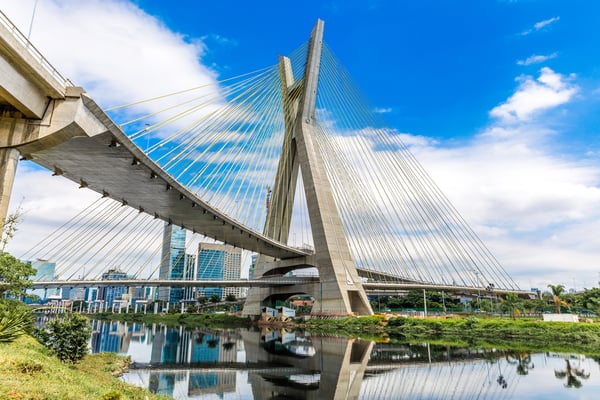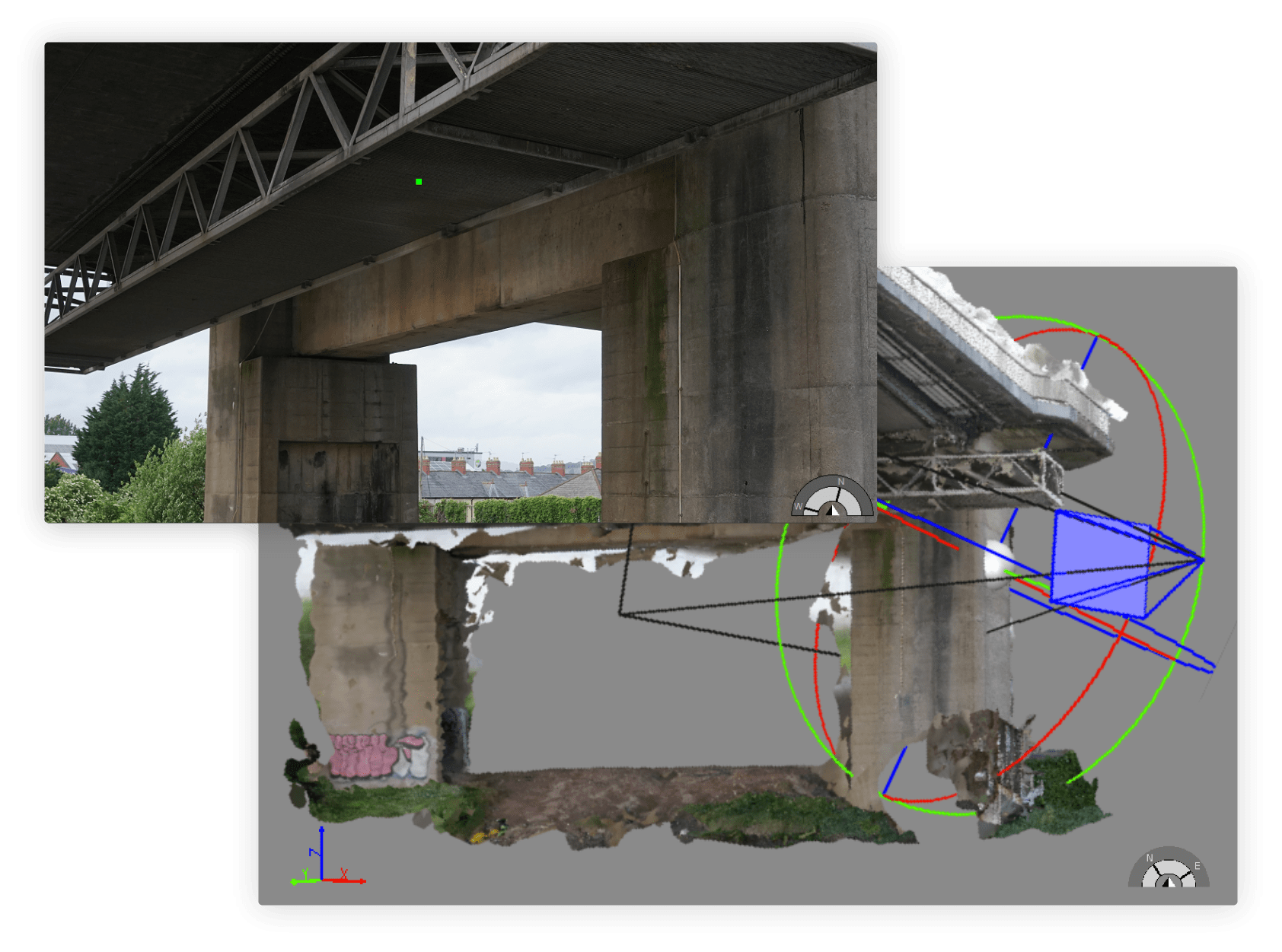A combination of digital twins and AI has great potential to improve bridge inspections in terms of quality, speed, and safety. As the technologies advance, they will equip bridge inspectors with a more efficient and cost-effective digital solution capable of inspecting a wide range of bridges. Incorporating artificial intelligence, IoT and other emerging technologies with the digital twin delivers various benefits to the bridge inspectors, road users, public and other stakeholders.
In practice, the digital twin is a virtual model that takes the real-world data of the physical bridge structure as its input. It then uses the data to build simulations and predictions that allow stakeholders to determine the impact of the inputs and how the bridge would respond or perform under such real-world conditions.
Generally, a digital twin allows the engineers to run simulations by feeding it with data from various sources including, but not limited to, drones, sensors, and other technologies. As technologies continue to evolve, stakeholders can pair the digital twins with enhancing technologies such as artificial intelligence, machine learning, augmented reality, the Internet of Things, and others to improve the outcome.
With bridge structures becoming more complex and difficult to inspect using traditional methods, a digital twin provides the engineers and stakeholders with the ability to simulate and create what-if scenarios using the virtual models, hence easily and cost-effectively determine the current and future status of the physical structure based on prevailing conditions. Once the engineers obtain quality inspection data, they can plan and carry out effective bridge maintenance. Depending on the analysis, they are also able to make decisions on whether the bridge requires major maintenance, rehabilitation, or replacement.

Challenges with traditional bridge inspections
Bridges are critical components of the road infrastructure and transportation networks. As such, maintaining them is critical in ensuring their integrity and public safety. Towards this, engineers require timely, up to date and detailed data about the structures. Which they can then analyze and share with other stakeholders. For a long time, some engineers have been conducting traditional manual bridge inspections. Unfortunately, these have various challenges including but not limited to requiring costly inspection gear and bulk climbing equipment, high costs, and risky inspections
Besides the safety risks, the traditional manual inspections are also time-consuming and inaccurate, especially when the workers cannot reach some of the locations close enough to capture in-depth or detailed images. Additionally, unless a road is closed, which in practice is not possible for busy highways, the best the workers can do is to probably close a single lane. This not only inconveniences the road users but is also a safety risk to both motorists, pedestrians, and workers.
In practice, bridge inspections can be difficult, for large, busy, and complex structures. Collecting data from such structures is usually a big challenge especially when using manual methods. Besides the safety risks from falls, the inspectors are also exposed to potential accidents from moving vehicles, interference from pedestrians, and other disturbances. Additionally, accessing some parts of the bridge is also difficult even and will require special climbing gear. And even with these, getting detailed information from the surfaces could still be a challenge.
Most of the time, the difficulty in taking the necessary measurements often leads to inaccuracies and has the potential to miss out on crucial data. For example, it is almost difficult to access some confined spaces or take detailed measurements and tests under the bridge while hanging on the climbing gear.
What is a digital twin and how does it work for bridge inspection
A digital twin is a virtual representation of the physical asset, system, or process. It contains all the technical information of a system which enables operators or engineers to model the asset and understand how a physical counterpart would behave under various real-world conditions. Today, the digital twins, drones, AI, and other emerging technologies are providing an effective solution to bridge inspection as well as for other fallibilities.
In a typical application, the digital twin will have 2D and 3D digital models that correspond to the bridge's physical structure. For the bridge design, the models will have 2D and 3D drawings while mechanical models are used for the structural analysis.
Engineers may also add health monitoring sensors to the entire structure. These will then collect the relevant data which is then fed into the models. This allows the engineers to determine to assess the bridge condition as well as safety risks if any. For visual inspections, the bridge companies can use drones to collect images, video footage, and measurements. Feeding this data to the digital twins enables them to assess the physical status of the bridge and identify visual defects such as cracks, corrosion, tear and wear, and more. Additionally, the digital twins can use historical and current data to predict their condition under certain conditions after a given time.
Benefits include reducing the bridge inspection costs, improving the level and quality of inspections while reducing the risks and liabilities. In particular, the combined technologies allow them to perform more detailed inspections, analyze the data, and identify faults in real-time. The inspectors can obtain trustworthy and accurate data from the structures more safely, cheaper and timely.

Using digital twins and AI for bridge inspections
Pairing the digital twin with AI enables it to perform intelligent analyses of the data hence provide better bridge inspections and insights. Consequently, the engineers can assess the digital representation of the bridge more accurately and estimate or predict the current status based on the prevailing environmental and usage conditions, even before going there physically.
Ideally, the digital twins combined with artificial intelligence provide a cost-effective, accurate, safer, and timely bridge inspection. For example, using the historical changes and operating conditions, the stakeholders can determine accurately determine the size and location of corrosion, a crack, or other weakness much faster and cost-effectively compared to manually analyzing images they have captured over a given time. Integrating it with data from other technologies such as IoT, sensors, continuous surveys, Lidar and others helps to improve its outcomes and quality of inspections.
Ideally, the digital twins and AI allows the teams to conduct most of the inspection tasks from their office, and this helps to save on cost and time.
Additionally, limiting the number of field operations as well as the use of risky traditional equipment reduces safety risks, costs, and liabilities. Integrating other technologies such as sensors and drones enable the teams to conduct in-depth inspections, acquire and analyze more data hence get an accurate assessment of the bridges.
Drones and digital twins
Use drones and other sensors to collect data plays a critical role in gathering valuable input for building the digital twin. Ideally, pairing the digital twin, AI, drones, and other technologies enables the engineers to collect, store, and analyze massive amounts of data. This allows them to conduct better and high-quality inspections at lower costs and within shorter times.
Today, many companies are using drones in conjunction with the digital twin to collect and analyze images from the bridges. The solution provides a cost-effective, holistic view of the bridge since the stakeholders can monitor the structure and changes occurring over time. Compared to manual methods, drones provide a wide range of benefits including being faster, less costly, and more effective. If equipped with communication technologies, the drone can transmit the images in real-time, hence allowing the operators to feed the data into the digital twins and make more informed, data-driven decisions quickly.
Additionally, the real-time operation means that the inspectors can make repeat footage or analyses in case they need more details or clarification. Other benefits include the ability to access confined spaces under and above the bridge, ability to capture images from the exact location as many times as possible, which is important when analyzing areas that have been repaired.
The advances in wireless sensors, IoT, cloud platforms, and communications technologies enable the collection and analysis of field data in real-time. In addition to embedding sensors on major structural elements or components, teams can use drones to collect visual images. The data can then be used as an input to the digital twins for real-time simulation and analysis.
Additionally, the digital twins and drones help to improve the safety of both the bridge inspection teams, road users, and the general public, while enabling them to perform regular inspections and maintenance in the future.
Integrating Digital twin with AI, and other supporting technologies
A digital twin and AI can improve the bridge inspection and maintenance activities by allowing the operators to remotely analyze or inspect the bridge from the office. Using other technologies such as sensors and drones to complement the digital twins allows them to enhance the data collection and safety as well as speed while reducing costs. Besides AI, other technologies that integrate and improve the digital twins include the Internet of Things (IoT), machine learning, ML, data analytics, big data, cloud, etc.
Integrating the digital twin with technologies such as AI, ML, IoT, and others opens up new opportunities and possibilities. Generally, a typical digital twin can consume and process massive amounts of data, and these supporting technologies allow it to even make more informed and human consumable outcomes even when inspecting complex bridges and structures.
The additional technologies help to improve the outcomes of the digital twins. In particular, AI enables teams to gain more useful and intelligent insights. With advances in wireless communication technologies and streaming analytics, it is possible to use artificial intelligence and machine learning technologies to analyze real-time data from sensors and other information collection technologies such as drones. For example, AI can help engineers analyze sensor data and detect faults in real time.
Conclusion
Today, the combination of the digital twin and AI is providing a cost-effective bridge inspection solution that allows engineers to perform simulations based on real-world conditions. The simulation provides useful insights that enable inspection engineers to understand the status of the bridge, and also predicts potential problems that require urgent or scheduled attention.
Besides the actual bridge structure, the sensors and drones can provide images, videos, and other valuable data about the surrounding, hence enhancing the digital twin outcome and planning for future maintenance activities.
